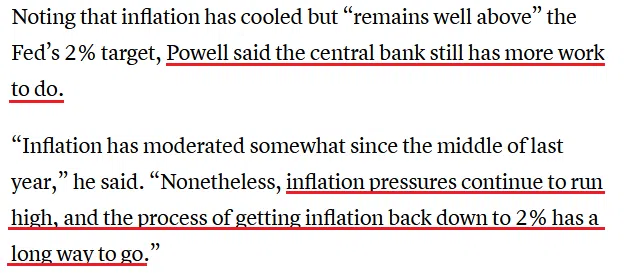Gold Can’t Dodge the Hawks
The yellow metal continues to confront fundamental pressure as stubborn growth, employment, and inflation keep monetary policy tight.
With central banks realizing that disinflation is occurring at a slower pace than they had hoped, they’ve adopted our thesis that interest rates are not high enough to normalize demand. And with their tough talk forcing investors to adjust, their renewed hawkishness has had a profound impact on gold. To explain, we wrote on Apr. 14:
Market participants are pricing in ~60 basis points of rate cuts. If those cuts get priced out, the market impact is similar to the Fed raising the U.S. federal funds rate (FFR). No matter how you slice it, no cuts means the FFR stays higher for longer, and a realization should have a profound impact on the PMs…..
Mining stocks are particularly vulnerable. The rate-cut optimism contrasts the realities on the ground, and market participants are overconfident because the Fed has been wrong more than it’s been right. However, we believe the QE bulls will suffer disappointment in the months ahead.
To that point, with the projection playing out exactly as expected, our GDXJ ETF short position continues to produce.
Please see below:

To explain, the black line above tracks the December 2023 FFR futures contract, while the gold line above tracks the GDXJ ETF. As you can see, both rallied sharply during the bank-run chaos as pivot optimism reigned. But the heavy declines on the right side of the chart show how a lower FFR futures price and a higher yield have not been celebrated by the junior miners. Consequently, the technicals and the fundamentals continue to align with our thesis.
The Fed Chorus
With the hawks circling the financial markets, Fed Chairman Jerome Powell said on Jun. 21:
“We have been seeing the effects of our policy tightening on demand in the most interest rate-sensitive sectors of the economy. It will take time, however, for the full effects of monetary restraint to be realized, especially on inflation….
“Nearly all FOMC participants expect that it will be appropriate to raise interest rates somewhat further by the end of the year.”
So, while Powell’s reality check has been heard loud and clear, like the GDXJ ETF, silver has also suffered amid the hawkish re-pricing. Moreover, we’ve been warning for months that demand-driven inflation would prove more stubborn than the consensus appreciated.
Please see below:

Likewise, Richmond Fed President Thomas Barkin said on Jun. 16:
“I am still looking to be convinced of the plausible story that slowing demand returns inflation relatively quickly [to 2%]. If the coming data doesn’t support that story, I’m comfortable doing more.
He added:
“The ’70s provides a clear lesson: if you back off inflation too soon, inflation comes back stronger, requiring the Fed to do even more, with even more damage. That’s not a risk I want to take.”
In addition, Fed Governor Christopher Waller said on Jun. 16:
“Core inflation is not coming down like I thought it would. Inflation is just not moving and that's going to require, probably, some more tightening to try to get that going down.”
Consequently, while prospective demand destruction hammered oil prices on Jun. 22, the Fed must continue its onslaught to realize material progress. And unfortunately, history shows that bouts of unanchored inflation end with recessions, which is the second half of our fundamental thesis.
Therefore, while we’re still in the first stage, the second stage is profoundly bearish for gold, silver, and mining stocks too. Remember, the U.S. dollar thrives alongside high volatility, and while the Cboe Volatility Index (VIX) remains severely depressed right now, a major spike should occur before this bear market ends.
In the meantime, though, we’ve warned repeatedly that Americans don’t borrow at the FFR. In contrast, they take out 10-30-year loans through mortgages, auto loans, and other long-term financing vehicles. And this matters because unless long-term rates rise, the FFR could hit 9%, and the economic impact will be minimal if the 10 and 30-Year Treasury yields stay near 3.5%.
If you analyze the graphic below, you can see that according to Mortgage News Daily, 30 and 15-year fixed-rate mortgages are still meaningfully below their 12-month highs, even though FFR expectations have risen dramatically. As a result, the Fed needs higher long-term Treasury yields to achieve its goals.

Overall, the S&P 500 remains relatively uplifted, even though commodities and bonds (to a somewhat lesser extent) have corrected. But the stock market suffers immensely when recessions hit, and we expect one to materialize before it’s all said and done.
Do you think the Fed can win this inflation war without a recession?
Alex Demolitor
Precious Metals Strategist